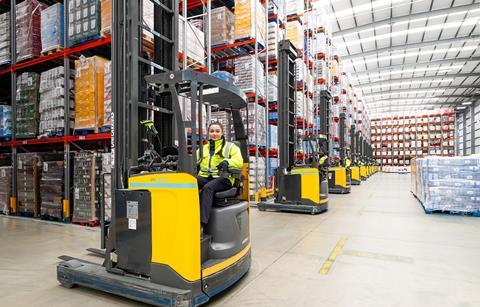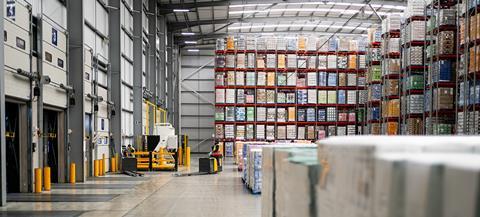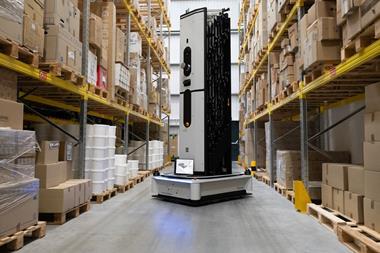With end-of-year festivities rapidly approaching, the challenge for grocery suppliers and retailers is to maximise efficiency and on-shelf availability. Discover the key tactics needed to optimise the supply chain during peak seasonal events throughout the year.
For FMCG manufacturers, peak seasonal events amount to more than just a busy period – they are a critical test of operational resilience. Seasonal surges, promotional activity and fluctuating consumer demand all put intense pressure on manufacturing, warehousing and transport networks. So, early and transparent communication between manufacturers, retailers and logistics providers is crucial to align expectations and resources, ensuring goods reach shelves when demand is at its highest.
Forecasting plays a central role in seasonal planning, as even small inaccuracies in volume projections can ripple through transport schedules, warehouse capacity, and labour capacity. For example, over-forecasting leads to wasted resources, while under-forecasting can trigger costly last-minute adjustments – from hiring temporary staff to sourcing additional transport. Sharing accurate forecasts early means manufacturers can reduce emergency costs, minimise stockouts, and maintain strong relationships with retailers.
External factors can also compound peak season challenges. Holidays, weather disruptions or supplier delays all create uncertainty, making proactive contingency planning essential. Manufacturers who anticipate these variables are better equipped to avoid operational bottlenecks and maintain continuity.

Warehouse planning: capacity, flexibility and technology
Warehouse operations should be carefully tailored to cater to peak demand. Facilities optimised for average throughput can often fall 15-20% short of the capacity needed during unexpected surges. So, flexibility in stock holding and order patterns is key, as is planning around inbound and outbound flows.
Business intelligence applications can convert customer forecasts into actionable storage and throughput plans. Meanwhile, weekly and daily review cycles become essential as the height of the season approaches, allowing operations to respond rapidly to unexpected demand shifts.
The importance of warehouse planning was highlighted by the example of a recent product launch into the UK, where a manufacturer failed to communicate an uplift in their inbound volumes and storage requirement of 10,000 pallet spaces. Without prior warning and sufficient planning, the warehouse had insufficient space to handle the stockholding surge, forcing the brand owner to lay out for expensive emergency off-site storage and double handling costs, with the additional high risk to service.
By contrast, another brand shared detailed volume forecasts months in advance, allowing resources to scale smoothly. As a result, supply chain costs were minimised, on-shelf availability maintained, and retailers reported zero disruption – a clear demonstration of the tangible benefits of proactive planning.

Transport: accurate forecasts and flexible planning
Transport plans also rely on accurate forecasts. Understanding daily and weekly volumes, stock build timescales and promotional cycles allows hauliers to allocate drivers and vehicles effectively. Flexibility is crucial, as contingency resources help absorb unexpected spikes without incurring excessive cost.
Timing and communication are equally important. Manufacturers should provide early and regular updates on production schedules, any anticipated uplifts and changes to promotional activity, giving transport partners the information needed to deliver consistently and on time.
By analysing historical peak periods, patterns in delivery bottlenecks and resource constraints can be identified, enabling smarter route planning and proactive allocation of fleet resources, reducing disruptions, and reinforcing retailer confidence.
Top 5 tips for peak planning
1. Start early: Begin peak planning months in advance, with high-level forecasts evolving into detailed week- and day-level projections.
2. Share information: Keep retailers, logistics partners and internal teams updated on volumes, timing and promotional plans.
3. Build flexibility: Plan contingencies for labour, stock and transport to absorb unexpected spikes.
4. Leverage technology: Forecasting and analytics tools turn historical and projected data into actionable operational plans.
5. Review and learn: Post-peak analysis refines processes, informs future planning, and strengthens partnerships.
Commercial insight: protecting on-shelf availability
Perhaps of greatest importance, peak season has a direct impact on in-store visibility, revenue and brand reputation. Retailers value reliability, responsiveness and proactive communication, so integrating promotional calendars and accurately forecasting demand can secure priority shelf placement and reduce the risk of lost sales. Post-peak reviews are equally important, as analysing forecast versus actual performance identifies bottlenecks, informs adjustments and strengthens supplier-retailer relationships.
Value-added services: supporting seasonal success
Promotional packaging, contract packing and e-fulfilment also require careful planning. Lead times for packaging materials and labour resources are critical and, if not addressed early, capacity constraints can become pinch point. Agile systems and responsive teams allow manufacturers to adjust quickly to last-minute changes in demand, keeping stock flowing efficiently to stores.
By early leveraging of value-added service (VAS) manufacturers can anticipate complexities such as bespoke labelling, bundled promotions or multi-pack configurations. Planning these elements in advance reduces the risk of errors, supports smoother outbound logistics, and helps products hit the shelves exactly when needed.

Peak season success is a balance of preparation, insight and operational agility. Manufacturers that invest in early planning, accurate forecasting and informed resource allocation can turn potential disruption into a competitive advantage, thereby protecting on-shelf availability and building retailer trust.
For tailored support in optimising seasonal success, contact Boughey Logistics.
Speak to our team to find out more about peak planning solutions.





















